 With the return of rain in September, and cooler temperatures, Oregon's mushroom season begins. I'm headed back to the Siuslaw National Forest, not far from the Pacific Ocean. Trip Date: September 22, 2017.
With the return of rain in September, and cooler temperatures, Oregon's mushroom season begins. I'm headed back to the Siuslaw National Forest, not far from the Pacific Ocean. Trip Date: September 22, 2017.

Time To Get Moving
A long time ago, in a Steemit post far away, I went on Part 1 of this walk in Oregon's Coastal Forest. To breathe in the fresh Pacific Ocean air that keeps this forest damp even in the dry season. And to forage for forest mushrooms.
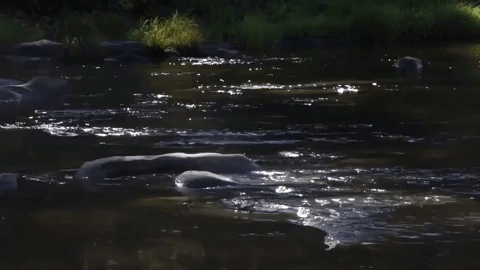 I left you sitting by the river, gazing deep into the thick forest moss. But now it's time to head into the the forest.
Since there are so many trees in this post, I'm posting it for Tree Tuesday, by @old-guy-photos. I like seeing all the trees on Tuesday!
I left you sitting by the river, gazing deep into the thick forest moss. But now it's time to head into the the forest.
Since there are so many trees in this post, I'm posting it for Tree Tuesday, by @old-guy-photos. I like seeing all the trees on Tuesday!

A Dense Coastal Forest
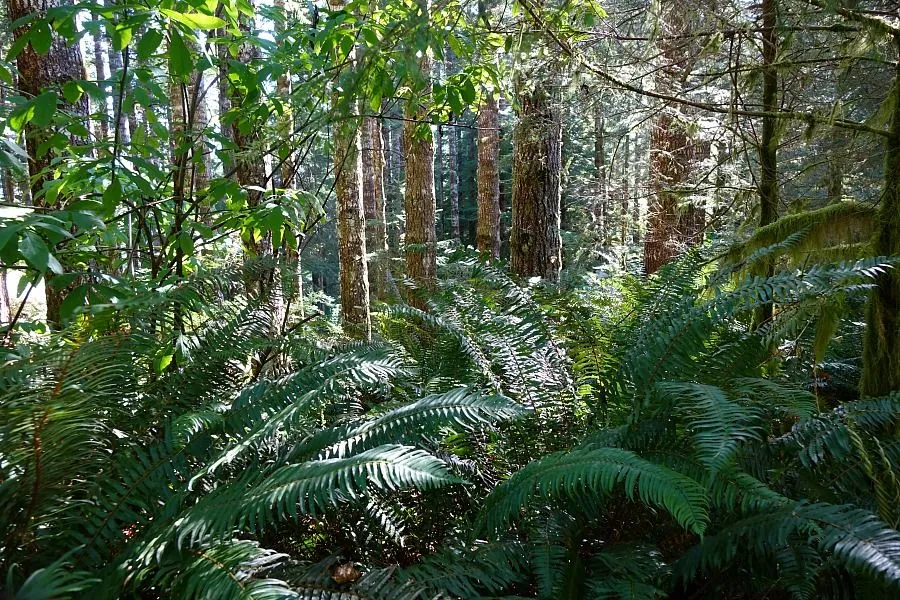 Forests along Oregon's West Coast are dense and big. These Western Sword Ferns are nearly 6 feet tall. This is a rainforest! This area usually gets more than 75 inches of rain every year. Even when it's not raining, the ferns and moss enjoy the fog rolling in from the Pacific Ocean.
In Part 1 of this walk, I asked, "What side of the tree does moss grow on?" Thanks to everyone who answered! As a way of atoning for my neglect of the contest, check your wallet if you gave an answer. I'll admit, this is an old nature joke that I can never resist when the opportunity is there. What's the answer? Check out this next picture!
Forests along Oregon's West Coast are dense and big. These Western Sword Ferns are nearly 6 feet tall. This is a rainforest! This area usually gets more than 75 inches of rain every year. Even when it's not raining, the ferns and moss enjoy the fog rolling in from the Pacific Ocean.
In Part 1 of this walk, I asked, "What side of the tree does moss grow on?" Thanks to everyone who answered! As a way of atoning for my neglect of the contest, check your wallet if you gave an answer. I'll admit, this is an old nature joke that I can never resist when the opportunity is there. What's the answer? Check out this next picture!
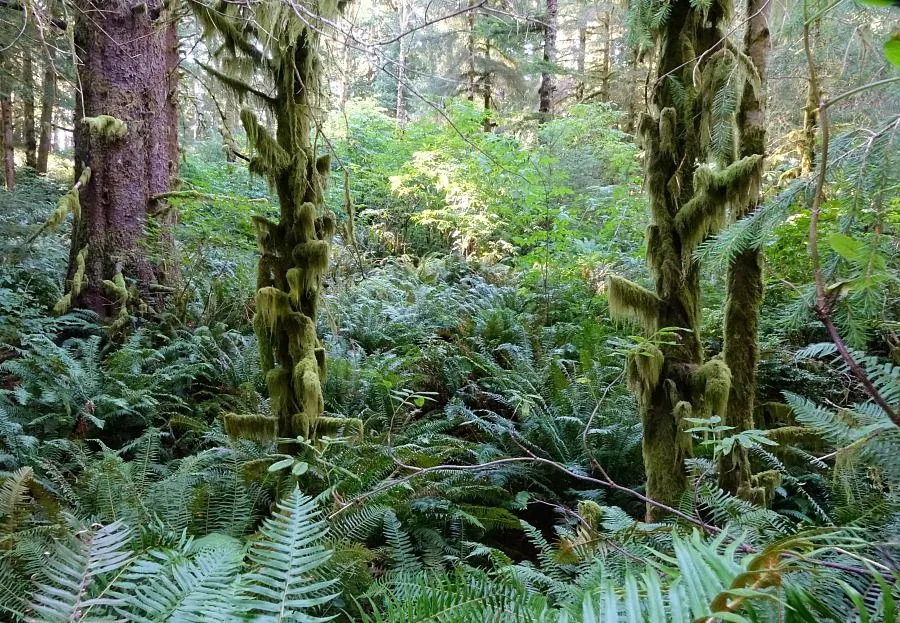 What side of a tree does the moss grow on? The Outside! The prize for the correct answer goes to @fishyculture. Moss grows any place where there's enough moisture. That could be any side of the tree -- except the inside, lol.
What side of a tree does the moss grow on? The Outside! The prize for the correct answer goes to @fishyculture. Moss grows any place where there's enough moisture. That could be any side of the tree -- except the inside, lol.
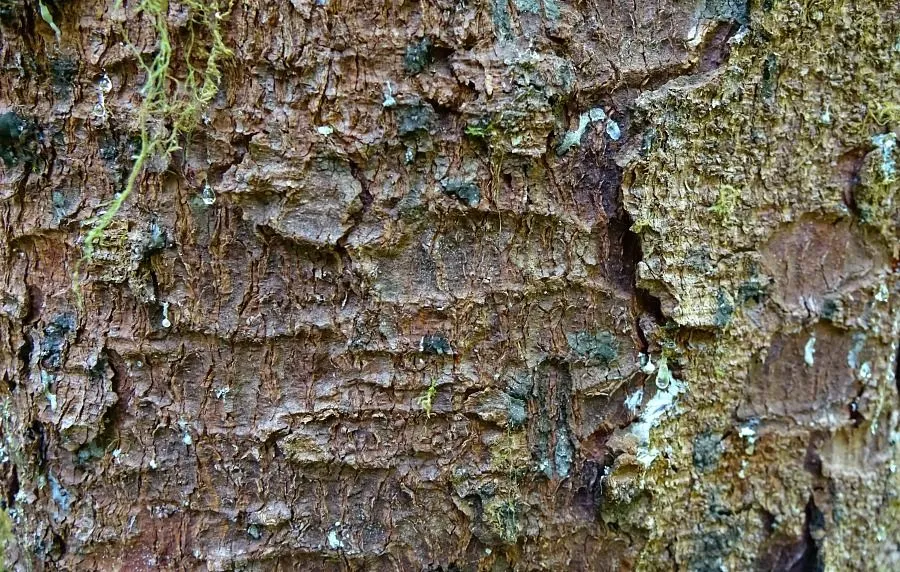 This is the bark of a Sitka Spruce, the iconic tree in the coastal forest. I can see bits of moss and lichen on the bark. And droplets of sticky sap -- this tree may be trying to fight off invasion by fungus by walling off parts of the tree with resin.[1]
This is the bark of a Sitka Spruce, the iconic tree in the coastal forest. I can see bits of moss and lichen on the bark. And droplets of sticky sap -- this tree may be trying to fight off invasion by fungus by walling off parts of the tree with resin.[1]

The Red-Belted Polypore!
Eventually, even the largest trees must fall. When they do, the trees support so much life as they decay back into the forest. One of the most common bracket fungus in forest trees is the Red-Belted Polypore. I make tea with this mushroom, like in my post for the Steemit Iron Chef contest: Fomitopsis Tea, Roasted Chanterelles, Deep-fried Elfin Saddles, with Candied Witches Butter and Cats Tongues!. But I left these in the forest.
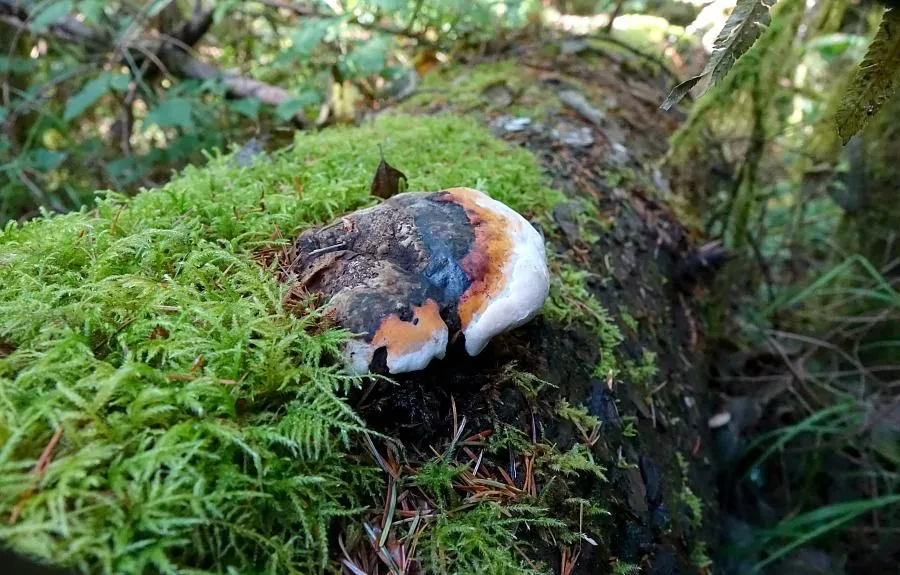 That orange belt between the whitish growing edge and the older, darker part, is a distinctive feature of the Red-belted Polypore. See how the mushroom "shelf" is growing parallel to the ground? That tells me that the mushroom came out of the tree only after the tree fell over.
That orange belt between the whitish growing edge and the older, darker part, is a distinctive feature of the Red-belted Polypore. See how the mushroom "shelf" is growing parallel to the ground? That tells me that the mushroom came out of the tree only after the tree fell over.
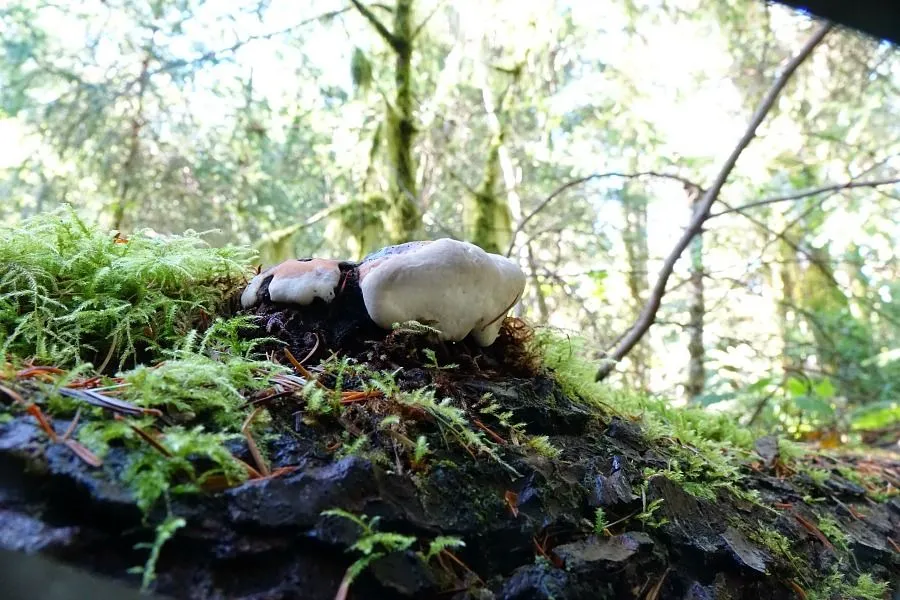 But how long has this mushroom been here? Red-belts can live for years! But look underneath the "shelf". It's not flat, more like a thick hoof. That tells me it's pretty young. Certainly not years old.
But how long has this mushroom been here? Red-belts can live for years! But look underneath the "shelf". It's not flat, more like a thick hoof. That tells me it's pretty young. Certainly not years old.
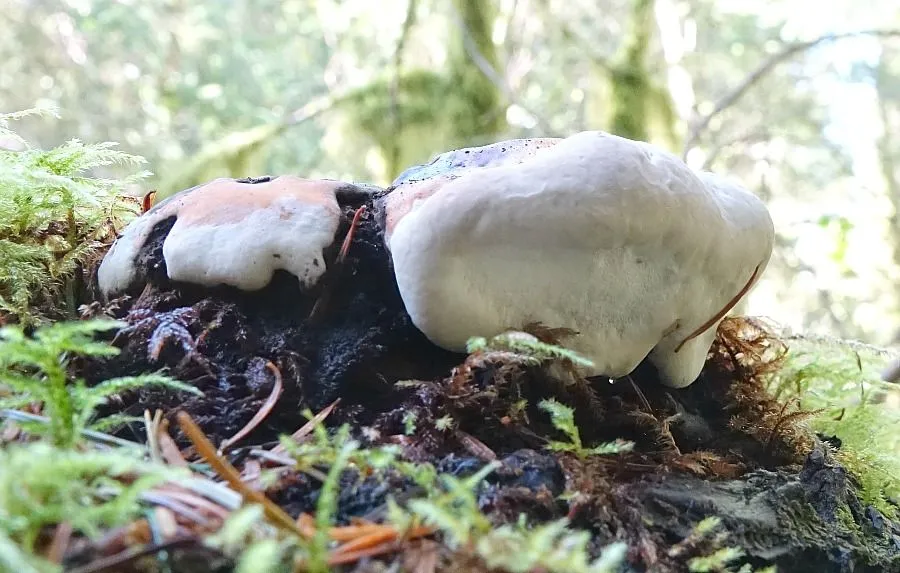 Let's look even closer at the underside. That chunk of the mushroom on the right has a flat part that's turning into the pores! I'm guessing this mushroom is from last year, but has started growing again this season -- putting on another layer of new pores. The way to tell for sure is to cut the mushroom in half and count the layers.
Let's look even closer at the underside. That chunk of the mushroom on the right has a flat part that's turning into the pores! I'm guessing this mushroom is from last year, but has started growing again this season -- putting on another layer of new pores. The way to tell for sure is to cut the mushroom in half and count the layers.
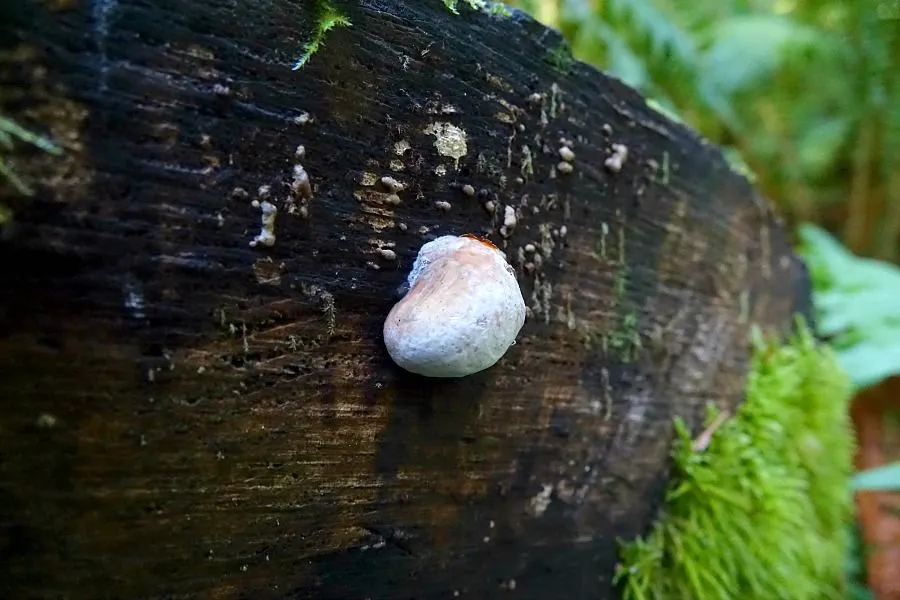 Here's another Red-belted Polypore. It's brand new! It's not a baby, since most of the fungus is really inside the tree. The mushrooms that we see are more like a fruit. A cute little baby mushroom-fruit!
Here's another Red-belted Polypore. It's brand new! It's not a baby, since most of the fungus is really inside the tree. The mushrooms that we see are more like a fruit. A cute little baby mushroom-fruit!

Lobsters in the Forest!
Going deeper into the forest, the thick tree cover shades out the Sword ferns and makes it easier to travel.
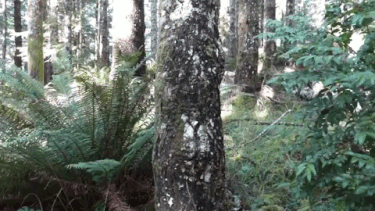 And then I notice something!
And then I notice something!
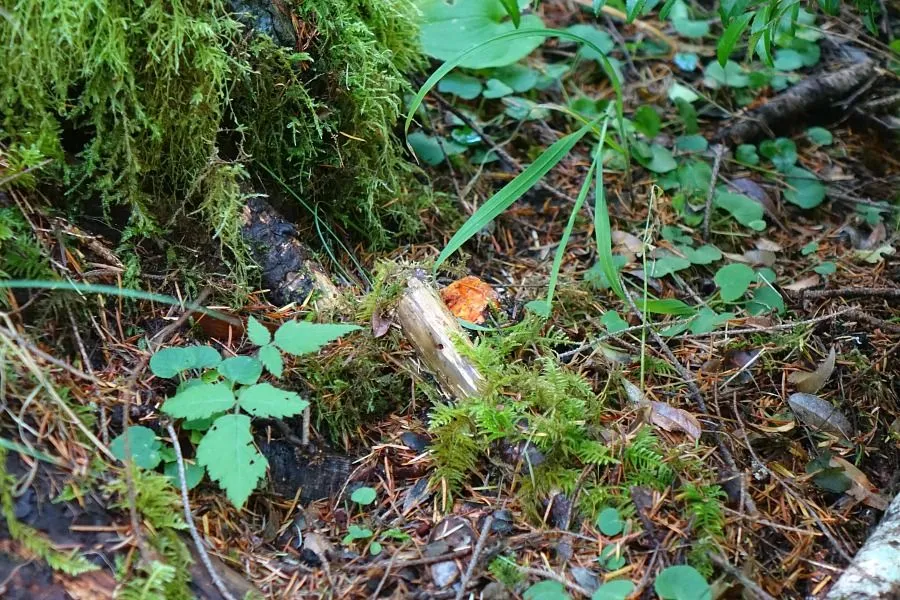 There it is, peeking out from the moss on the forest floor.
There it is, peeking out from the moss on the forest floor.
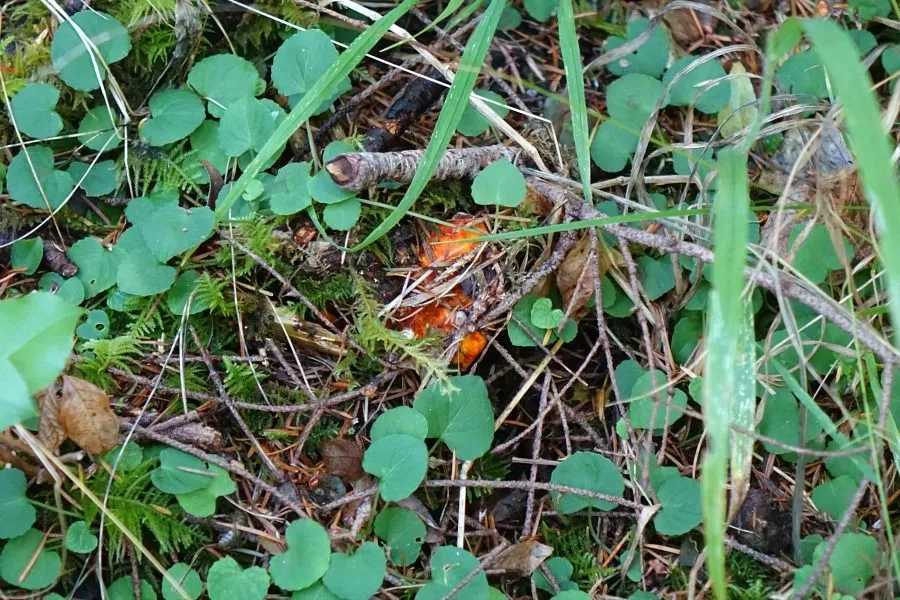 And there's another one!
And there's another one!
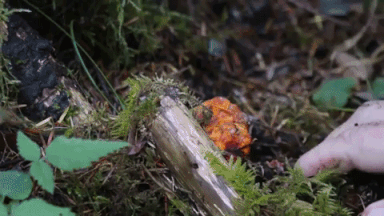 I check out one -- and pull it out!
I check out one -- and pull it out!
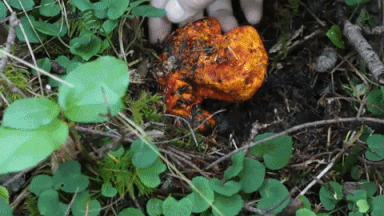 And here's the other one!
What are these? Lobster mushrooms! Amazing -- 2 fungi together, with 1 a parasite on the other! Life is harsh in the forest!
I used these for another Steemit Iron Chef entry, Grilled Squash Blossoms Stuffed with Wild Lobster Mushrooms. You can see how I identified and cleaned them in my post, How To Eat Wild Forest Lobsters. And if you want to see lots of identification details, here's a video I made about using a mushroom identification key.
And here's the other one!
What are these? Lobster mushrooms! Amazing -- 2 fungi together, with 1 a parasite on the other! Life is harsh in the forest!
I used these for another Steemit Iron Chef entry, Grilled Squash Blossoms Stuffed with Wild Lobster Mushrooms. You can see how I identified and cleaned them in my post, How To Eat Wild Forest Lobsters. And if you want to see lots of identification details, here's a video I made about using a mushroom identification key.

Spring Water!
On the way back home, I stopped off at the spring I showed in an earlier walk. This time, I had a helper and some containers.
 I've searched and searched for information on this spring, without success. It's not even on a US Geological Survey map! But I see a lot of people coming here to get water and they all have said this is good water. It's coming out of the base of a big hill that's covered with coastal rainforest. So I'm OK with drinking it.
I've searched and searched for information on this spring, without success. It's not even on a US Geological Survey map! But I see a lot of people coming here to get water and they all have said this is good water. It's coming out of the base of a big hill that's covered with coastal rainforest. So I'm OK with drinking it.
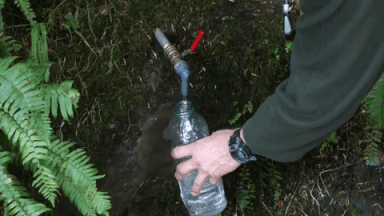 The water doesn't flow fast, but it was good-tasting water!
The water doesn't flow fast, but it was good-tasting water!

Thanks for Walking With Me
I'll be continuing my series of travels to parts of western Oregon all through the autumn of 2017. I hope you will join me -- especially if you like mushrooms! Earlier posts in this series are: Escape to the Marine Layer - Part 1 and Part 2. // Saunter in the Siuslaw - Part 1 and Part 2 // Foraging in Oregon's Coastal Forest - Part 1
Thanks to @lyndsaybowes for the #walkwithme tag! And to everyone using that tag! Enjoy your walks!
- Have you ever been in a rainforest?
- Have you ever seen a Red-belted Polypore?
- Do you have any natural springs near you?
- Would you drink that spring water?

Plant List
- Western sword fern - Polystichum munitum
- Sitka spruce - Picea sitchensis
- Red-belted polypore - Fomitopsis pinicola
- Lobster mushroom - Hypomyces lactifluorum parasite on Russula brevipes
References:
[1] Compartmentalization of decay in trees
This post is on the Steemit World Map
Haphazard Homestead
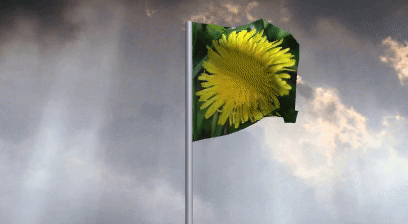 foraging, gardening, nature, simple living close to the land
All content is 100% Haphazard Homestead!My YouTube channel: Haphazard Homestead
foraging, gardening, nature, simple living close to the land
All content is 100% Haphazard Homestead!My YouTube channel: Haphazard Homestead 






















